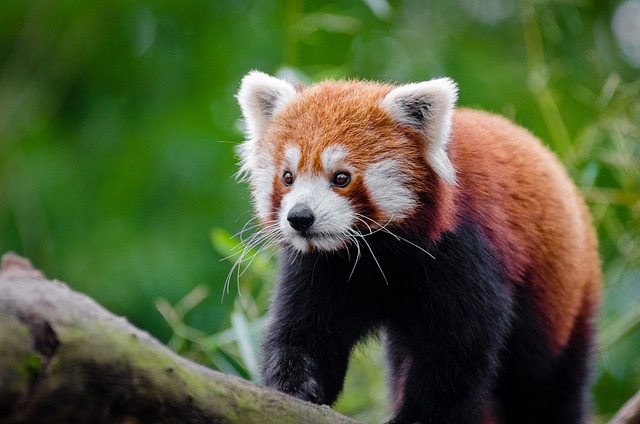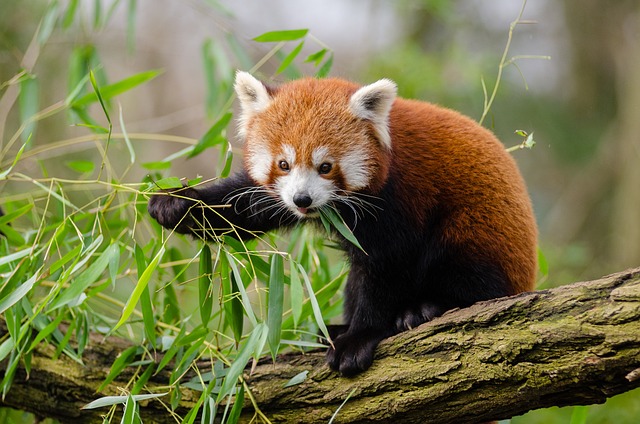Deep in the dense forests of the eastern Himalayas lives a creature that seems to have stepped out of a storybook – the red panda (Ailurus fulgens). Often called the "little panda" or "firefox" due to its resemblance to both pandas and foxes, this small, arboreal mammal captivates the hearts of all who encounter it. With its adorable appearance and elusive nature, the red panda symbolizes both the fragility and resilience of our planet's biodiversity.
The red panda's name is a nod to its vibrant fur, which ranges from fiery red to chestnut brown, highlighted by creamy white markings around its face and ears. Its large, expressive eyes radiate curiosity and intelligence, adding to its charm. Despite its name, the red panda has no direct relation to the giant panda, it belongs to its own unique family, Ailuridae, and is considered a living fossil due to its ancient lineage.
Found primarily in the temperate forests of Nepal, India, Bhutan, China and Myanmar, the red panda is a creature of the mountains, preferring altitudes between 2,200 and 4,800 meters (7,200 and 15,700 ft). It thrives in dense thickets of bamboo forests, where it can eat its favorite food – bamboo shoots – as well as fruits, acorns, eggs and insects, demonstrating its opportunistic omnivorous diet.
Arboreal by nature, the red panda is well adapted to life in trees. Its semi-retractable claws and long, bushy tail aid in balance and agility, while its thick fur provides insulation against the cold mountain wind. Red pandas are primarily solitary creatures, except during breeding season or when mothers are nursing their young. Their elusive behavior and nocturnal habits make them rare in the wild, adding to their allure.
Despite its adorable appearance, the red panda faces many threats to its existence. Habitat loss due to deforestation, fragmentation and human encroachment remains one of the most significant challenges. Additionally, poaching, illegal wildlife trade, and conflicts with domestic animals further threaten their populations. Climate change also poses a threat, causing changes in the distribution of bamboo and disrupting the red panda's habitat.
Recognizing the urgent need for action, conservation organizations and local communities have rallied to protect the red panda and its habitat. Efforts include establishing protected areas, promoting sustainable land-use practices, and raising awareness of the importance of biodiversity conservation. Community-based ecotourism initiatives have also emerged, offering alternative livelihoods while fostering a sense of stewardship among local residents.
Despite the challenges, there is hope for the future of the red panda. Conservation initiatives, with increasing public awareness and support, offer a glimmer of optimism. Collaborative research efforts have shed light on the ecology, behavior, and genetic diversity of the red panda, providing valuable insights for conservation strategies. Additionally, initiatives to reduce human-wildlife conflict and address the root causes of habitat loss are gaining momentum.
The plight of the red panda is a poignant reminder of the interconnectedness of all life forms and the delicate balance of ecosystems. As an ambassador for conservation, it symbolizes the broader struggle to preserve the Earth's rich biodiversity for future generations. Its charismatic presence has the power to inspire action and foster a deeper appreciation for the wonders of the natural world.
Here are some interesting facts about the red panda:
- Uniqueness Test: Red pandas belong to their own unique family, Ailuridae, and giant pandas do not belong to their own unique family. He is a fully alive member of this family.
- Himalayan Habitat: Red pandas primarily inhabit the temperate forests of the eastern Himalayas, which extend across Nepal, India, Bhutan China, and Myanmar. They are often found on the coast between 2,200 and 4,800 meters (7,200 and 15,700 ft).
- Arborial lifestyle: These creatures are excellent climbers and spend most of their lives in trees. Their semi-retractable discount and long, bushy tail helps them maintain balance while keeping them at the basket.
- Nocturnal habits: Red pandas are primarily active during the cool of the dawn and dusk, making them crepuscular. Their nocturnal habits help them avoid diurnal animals and skate by with predators.
- Dietary parameters: Bamboo makes up the majority of the red panda's diet, although they are classified as omnivores. They also consume fruits, carrion, eggs, insects and sometimes the fruit of small tits.
- Adaptations to cold climates: Red pandas have thick, dense forests that help them survive cold temperatures. Their fur is taught to the soles of their remains, helping to retain heat and grip on icy objects.
- Solitary nature: Red pandas are generally found as solitary animals, well into mating season or when females are raising their cubs. Their reflexes include scent glands, which they use to make plays and communicate with other red pandas.
- Distinctive Appearance: Red pandas are known for their attractive appearance, featuring reddish-brown fur with white markings on their face and nose. His large, expressive effects add to his charm and appeal.
- Endangered Status: The red panda is classified as Endangered by the International Union for Conservation of Nature (IUCN) due to habitat loss, fragmentation, poaching, and illegal illegal trade. Their efforts for conservation are important.



Comments
Post a Comment